Lincoln Cathedral: Difference between revisions
No edit summary |
|||
| Line 131: | Line 131: | ||
*"Lincoln Cathedral: Official Guide", Diocese of Lincoln | *"Lincoln Cathedral: Official Guide", Diocese of Lincoln | ||
*"Lincoln Cathedral" by Peter B G Binnall, Pitkin Publishing (ISBN 978-0-85372-203-8) | *"Lincoln Cathedral" by Peter B G Binnall, Pitkin Publishing (ISBN 978-0-85372-203-8) | ||
{{Cathedrals of the Church of England}} | |||
Latest revision as of 17:27, 16 October 2022
| Lincoln Cathedral | |
|
The Cathedral Church of St Mary the Virgin of Lincoln | |
|---|---|
|
Lincoln, Lincolnshire | |
| Status: | Cathedral |
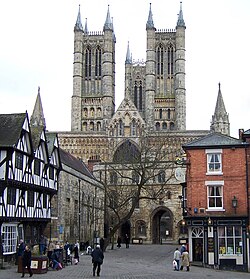 Lincoln Cathedral from Castle Hill | |
| Church of England | |
| Diocese of Lincoln | |
| Location | |
| Grid reference: | SK97807181 |
| Location: | 53°14’4"N, -0°32’10"W |
| History | |
| Built 1185–1311 | |
| Gothic | |
| Information | |
| Website: | www.lincolncathedral.com |
The Cathedral Church of the Blessed Virgin Mary of Lincoln, commonly known as Lincoln Cathedral is the episcopal seat of the Diocese of Lincoln. It stands on the hill in the centre of the city of Lincoln, the county town of Lincolnshire.
This is one of the great cathedrals of the Church of England. Building commenced in 1088 and continued in several phases throughout the High Middle Ages. It was reputedly the tallest building in the world for 238 years (1311–1549).[1][2][3] The central spire collapsed in 1549 and was not rebuilt. The cathedral is the third largest in Britain (in floor space) after St Paul's in London and York Minster, being 484 feet by 271 feet. It is Lincolnshire's largest building. It is highly regarded by architectural scholars; the eminent Victorian writer John Ruskin declared: "I have always held... that the cathedral of Lincoln is out and out the most precious piece of architecture in the British Isles and roughly speaking worth any two other cathedrals we have."
History
Remigius de Fécamp, the first bishop of Lincoln, moved the Episcopal seat there "some time between 1072 and 1092"[4] About this, James Essex writes "Remigius ... laid the foundations of his Cathedral in 1088", and "it is probable that he, being a Norman, employed Norman masons to superintend the building ... though he could not complete the whole before his death."[5]
Before that, writes B. Winkles, "It is well known that Remigius appropriated the parish church of St Mary Magdalene in Lincoln, although it is not known what use he made of it."[6]
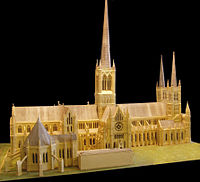
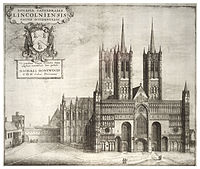
Up until then St Mary's Church in Stow was considered to be the "mother church"[7] of Lincolnshire[8] (although it was not a cathedral, because the seat of the diocese was at Dorchester Abbey in Dorchester-on-Thames, Oxfordshire). However, Lincoln was more central to a diocese that stretched from the Thames to the Humber.
Bishop Remigius built the first Lincoln Cathedral on the present site, finishing it in 1092 and then dying on 9 May of that year, two days before it was consecrated. In 1141, the timber roofing was destroyed in a fire. Bishop Alexander rebuilt and expanded the cathedral, but it was mostly destroyed by an earthquake about forty years later, in 1185 (dated by the BGS as occurring 15 April 1185).[6][9] The earthquake was one of the largest felt in the UK: it has an estimated magnitude of over 5. The damage to the cathedral is thought to have been very extensive: the Cathedral is described as having "split from top to bottom"; in the current building, only the lower part of the west end and of its two attached towers remain of the pre-earthquake cathedral.[9] Some have suggested that the damage to Lincoln Cathedral was probably exaggerated by poor construction or design; with the actual collapse most probably caused by a vault collapse.[9]
After the earthquake, a new bishop was appointed. He was Hugh de Burgundy of Avalon, France, who became known as St Hugh of Lincoln. He began a massive rebuilding and expansion programme. Rebuilding began with the choir (St. Hugh's Choir) and the eastern transepts between 1192 and 1210.[10] The central nave was then built in the Early English Gothic style. Lincoln Cathedral soon followed other architectural advances of the time – pointed arches, flying buttresses and ribbed vaulting were added to the cathedral. This allowed support for incorporating larger windows. There are thirteen bells in the south-west tower, two in the north-west tower, and five in the central tower (including Great Tom). Accompanying the cathedral's large bell (instrument)|bell, Great Tom of Lincoln, is a quarter-hour striking clock. The clock was installed in the early 19th century.[11] The two large stained glass rose windows, the matching Dean's Eye and Bishop's Eye, were added to the cathedral during the late Middle Ages. The former, the Dean's Eye in the north transept dates from the 1192 rebuild begun by St Hugh, finally being completed in 1235. The latter, the Bishop's eye, in the south transept was reconstructed a hundred years later in 1330.[12] A contemporary record, "The Metrical Life of St Hugh", refers to the meaning of these two windows (one on the dark, north, side and the other on the light, south, side of the building):
"For north represents the devil, and south the Holy Spirit and it is in these directions that the two eyes look. The bishop faces the south in order to invite in and the dean the north in order to shun; the one takes care to be saved, the other takes care not to perish. With these Eyes the cathedral’s face is on watch for the candelabra of Heaven and the darkness of Lethe (oblivion)."
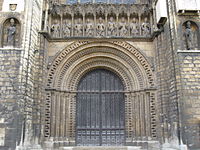
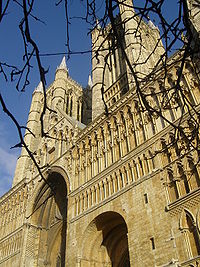
After the additions of the Dean's eye and other major Gothic additions it is believed some mistakes in the support of the tower occurred, for in 1237 the main tower collapsed. A new tower was soon started and in 1255 the Cathedral petitioned Henry III to allow them to take down part of the town wall to enlarge and expand the Cathedral, including the rebuilding of the central tower and spire. They replaced the small rounded chapels (built at the time of St Hugh) with a larger east end to the cathedral. This was to handle the increasing number of pilgrims to the Cathedral, who came to worship at the shrine of Hugh of Lincoln.
In 1290 Eleanor of Castile died and King Edward I of England decided to honour her, his Queen Consort, with an elegant funeral procession. After her body had been embalmed, which in the 13th century involved evisceration, Eleanor's viscera were buried in Lincoln cathedral, and Edward placed a duplicate of the Westminster tomb there. The Lincoln tomb's original stone chest survives; its effigy was destroyed in the 17th century and replaced with a 19th-century copy. On the outside of Lincoln Cathedral are two prominent statues often identified as Edward and Eleanor, but these images were heavily restored in the 19th century and they were probably not originally intended to depict the couple.
Between 1307 and 1311 the central tower was raised to its present height of 271 feet. The western towers and front of the cathedral were also improved and heightened. At this time, a tall lead-encased wooden spire topped the central tower but was blown down in a storm in 1549. With its spire, the tower reputedly reached a height of 525 feet (which would have made it the world's tallest structure, surpassing the Great Pyramid of Giza, which held the record for almost 4,000 years). This height is agreed by most sources[13][14][15][16] though not universally so accepted.[1] Other additions to the cathedral at this time included its elaborate carved screen and the 14th-century misericords, as was the Angel choir. For a large part of the length of the cathedral, the walls have arches in relief with a second layer in front to give the illusion of a passageway along the wall. However the illusion does not work, as the stonemason, copying techniques from France, did not make the arches the correct length needed for the illusion to be effective.
In 1398 John of Gaunt and Katherine Swynford founded a chantry in the cathedral, to pray for the welfare of their souls, and in the 15th century the building of the cathedral turned to chantry or memorial chapels. The chapels next to the Angel Choir were built in the Perpendicular style, with an emphasis on strong vertical lines, which survive today in the window tracery and wall panelling.
Magna Carta
The bishop of Lincoln, Hugh of Wells, was one of the signatories to the Magna Carta and for hundreds of years the cathedral held one of the four remaining copies of the original, now securely displayed in Lincoln Castle.[17] There are three other surviving copies; two at the British Library and one at Salisbury Cathedral.[18]
Little Saint Hugh
In August 1255 the body of an 8-year-old boy was found in a well in Lincoln. He had been missing for nearly a month. This incident became the source of a blood libel in the city, with Jews accused of his abduction, torture, and murder. Many Jews were arrested and eighteen were hanged. The boy became named as Little Saint Hugh to distinguish him from Saint Hugh of Lincoln, but he was never officially canonised (made a saint).
The cathedral benefited from these events because Hugh was seen as a martyr, and many devotees came to the city and cathedral to venerate him. Chaucer mentions the case in "The Prioress's Tale" and a ballad was written about it in 1783. In 1955 a plaque was put up near "the remains of the shrine of ‘Little St Hugh’" in the cathedral, that decries the "Trumped up stories of 'ritual murders' of Christian boys by Jewish communities."
The Lincoln Imp
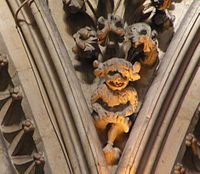
One of the stone carvings within the Cathedral is the Lincoln Imp. There are several variations of the legend surrounding the figure. According to 14th-century legend, two mischievous imps were sent by Satan to do evil work on Earth. After causing mayhem elsewhere in Northern England the two imps headed to Lincoln Cathedral, where they smashed tables and chairs and tripped up the Bishop. An angel appeared in the Angel Choir and ordered them to stop. One of the imps sat atop a stone pillar and started throwing rocks at the angel whilst the other cowered under the broken tables and chairs. The angel turned the first imp to stone, allowing the second imp to escape. The imp that turned to stone can still be found sitting atop his stone column in the Angel Choir.
Wren library
The Wren Library houses a rare collection of over 277 manuscripts, including the text of the Venerable Bede.
Rose windows
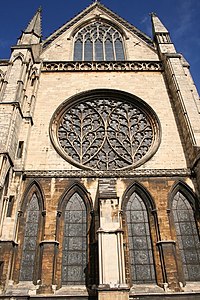
Lincoln Cathedral features two major rose windows, which are a highly uncommon feature among mediæval architecture in England. On the north side of the cathedral there is the "Dean's Eye" which survives from the original structure of the building and on the south side there is the "Bishop's Eye" which was most likely rebuilt circa 1325–1350. This south window is one of the largest examples of curvilinear tracery seen in mediæval architecture. Curvilinear tracery is a form of tracery where the patterns are continuous curves. This form was often done within pointed arches and squared windows because those are the easiest shapes, so the circular space of the window was a unique challenge to the designers. A solution was created that called for the circle to be divided down into smaller shapes that would make it simpler to design and create. Curves were drawn within the window which created four distinct areas of the circle. This made the spaces within the circle where the tracery would go much smaller, and easier to work with. This window is also interesting and unique in that the focus of the tracery was shifted away from the centre of the circle and instead placed in other sections. The glazing of the window was equally as difficult as the tracery for many of the same reason; therefore, the designers made a decision to cut back on the amount of iconography within the window. Most cathedral windows during this time displayed many colourful images of the bible; however at Lincoln there are very few images. Some of those images that can be seen within the window include saints Paul, Andrew, and James.
Wooden trusses
Wooden trusses offer a solid and reliable source of support for building because, through their joints, they are able to resist damage and remain strong. Triangles are the strongest shape because, no matter where the force is being placed on them, they are able to use their three joints to their fullest extent to withstand it. Making trusses with triangles inside larger triangles adds even more strength, as seen in Lincoln's choir. The design of all wooden trusses is a tedious task as there are many different things that need to be considered while building these supports. There are many different ways that the trusses can fail, if they are not designed or built properly; it is therefore crucial to design trusses that suit a specific building with specific needs in mind. The simplest form of a truss is an A-frame; however, the great amount of outward thrust generated by this often causes the truss to fail. The addition of a tie beam creates a triangular shape, although this beam can sometimes sag if the overall truss is too large. Neither one of these types would have been suitable for Lincoln, owing to the sheer size of the roof. They would have failed to support the building, so collar beams and queen posts were added to help prevent sagging. To protect against wind damage, braces were added. Secondary rafters were also added to the design to ensure that the weight was equally distributed. Saint Hugh's Choir has a total of thirty six trusses keeping the roof in place, and it is held up entirely by means of its own weight and forces.
Vaults
One major architectural feature of Lincoln Cathedral are the spectacular vaults. The varying vaults within the cathedral are said to be both original and experimental. The vaults especially, clearly define the experimental aspect seen at Lincoln. There are several different kinds of vaults that differ between the nave, aisles, choir, and chapels of the cathedral. Along the North Aisle there is a continuous ridge rib with a regular arcade that ignores the bays. Meanwhile, on the South Aisle there is a discontinuous ridge rib that puts an emphasis on each separate bay. The North West Chapel has quadripartite vaults and the South Chapel has vaults that stem from one central support columns. The use of sexpartite vaults allowed for more natural light to enter the cathedral through the clerestory windows, which were placed inside of each separate bay. Saint Hugh's Choir exhibits extremely unusual vaults. It is a series of asymmetrical vaults that appear to almost be a diagonal line created by two ribs on one side translating into only a single rib on the other side of the vault. This pattern divides up the space of the vaults and bays, perfectly placing the emphasis on the bays. The chapter house vaults are also interesting. It is a decagonal building with a single, central column that twenty ribs rise from. Each separate area of Lincoln can be identified solely by the different vaults of the space. Each vault, or each variation of the vault, is fresh and original. They illustrate innovative thinking and great creativity. There is no doubt that these vaults, and all of the other experimental aspects of Lincoln came with a slight risk.
Modern History

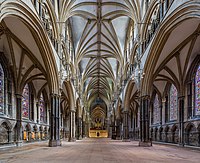
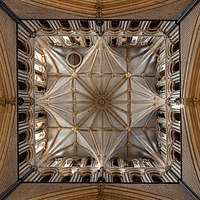
During the war, 'priceless British treasures' were placed in a chamber sixty feet beneath the cathedral for safekeeping.[19] This did not include the cathedral's copy of the Magna Carta as it was on loan in the United States.[19]

According to the cathedral website, over £1 million a year is spent keeping the cathedral in shape; the most recent project completed has been the restoration of the West Front in 2000. Soon after it was discovered that the flying buttresses on the east end were no longer connected to the adjoining stonework, and repairs were made to prevent collapse. The most recent problem was the discovery that the stonework of the Dean's Eye window in the transept was crumbling, meaning that a complete reconstruction of the window has had to be carried out according to the conservation criteria set out by the International Council on Monuments and Sites.
There was a period of great anxiety when it emerged that the stonework needed to shift only 5 mm for the entire window to collapse. Specialist engineers removed the window's tracery before installing a strengthened, more stable replacement. In addition to this the original stained glass was cleaned and set behind a new clear isothermal glass which offers better protection from the elements. By April 2006 the renovation project was completed at a cost of £2 million.
Recently, concerns have been growing once more about the state of the West Front, as there has been some stonework falling, which has raised questions as to the effectiveness of the repairs carried out in 2000.
Between 2006 and 2009, 200,000 to 208,000 people visited Lincoln Cathedral annually. In 2010 the figure dropped to 150,000, making it the 16th-most visited attraction in the East Midlands.[20] The fall in visitor numbers was attributed to the cancellation of the Lincoln Christmas Market that year.[21] The admission fee is £8.00, with concessions. The Cathedral website states; "Everyone is free to enter and gaze at the glory of the nave; you can sit in the peace of the Morning Chapel or visit the shop. If you want to explore further, we do ask you to pay."[22] The cathedral offers tours of the cathedral, the tower and the roof. The peak of its season is the Lincoln Christmas Market, accompanied by a massive annual production of Handel's Messiah.
On film
The cathedral has been used for the filming on occasion. In The Da Vinci Code the Cathedral took on the role of Westminster Abbey, as the Abbey had refused to permit filming, and there was protest at the filming.[23]
The cathedral also doubled as Westminster Abbey for the film Young Victoria, filmed in September 2007.[24][25]
Music
Choir
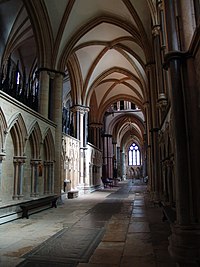
The Choir is currently formed of ten Gentlemen (who are either Lay Vicars or Choral Scholars), a team of about 20 boys and a team of about 20 girls.
The Cathedral accepted female choristers in 1995. Lincoln was only the second Cathedral in the country to adopt a separate girls' choir, after Salisbury Cathedral, and remains one of few who provide exactly the same musical opportunities and equal weekly singing duties to both girls and boys. All the choristers are educated at Lincoln Minster School.
Organ
The organ is one of the finest examples of the work of 'Father' Henry Willis, dating from 1898. It was Willis' last cathedral organ before his death in 1901. It has undergone two restorations, in 1960 and 1998, by Harrison & Harrison. The organ specification can be found in the National Pipe Organ Register.[26]
The installation of a new organ was made possible in 1898, after a donation by a Lincoln industrialist, Alfred Shuttleworth, of £1,000 towards the total cost of £4,675. The remainder was met by several other individual donations and public subscription. The organ is one of only two Willis organs in English cathedrals which retain their original tonal scheme.
The new organ, based on Willis's 1885 design, was dedicated on St Hugh's Day, 17 November 1898. It was intended to be the first British cathedral organ to be electrically powered. As Lincoln's power station had not yet entered service, however, it had to be pumped manually by soldiers of the Lincolnshire Regiment.[27]
Pictures
-
Flying buttresses at the decagonal chapter house
-
12th-century carving of Adam and Eve eating apples
-
Typically Norman 12th-century decoration on the west front
Outside links
| ("Wikimedia Commons" has material about Lincoln Cathedral) |
- Lincoln Cathedral
- Choir Association
- The Cathedral Church of Lincoln: a history and description of its fabric
- Large collection of pictures and info on Lincoln Cathedral
- The Association of the Friends of Lincoln Cathedral
- Capturing Lincoln Cathedral
- Adrian Fletcher's Paradoxplace – Lincoln Cathedral Pages
- A history of the choristers of Lincoln Cathedral
- Flickr images tagged Lincoln Cathedral
- Conserving the Dean's Eye window, Ingenia Magazine, December 2007
- Spire graphical reconstruction
- National Monuments Record: No. 326631 – Lincoln Cathedral historical record
References
- ↑ 1.0 1.1 Kendrick, A. F. (1902). "2: The Central Tower". The Cathedral Church of Lincoln: A History and Description of its Fabric and a List of the Bishops. London: George Bell & Sons. p. 60. ISBN 978-1-178-03666-4. "The tall spire of timber, covered with lead, which originally crowned this tower reached an altitude, it is said, of 525 feet; but this is doubtful. This spire was blown down during a tempest in January 1547-8."
- ↑ Mary Jane Taber (1905), The cathedrals of England: an account of some of their distinguishing characteristics, p.100
- ↑ "Lincoln Cathedral - History". The Dean and Chapter of Lincoln Cathedral. http://lincolncathedral.com/building/history/. Retrieved 8 December 2011. "Between 1307 and 1311 the central tower was raised to its present height. Then around 1370 to 1400 the western towers were heightened. All three towers had spires until 1549 when the central tower's spire blew down. It had been the tallest building in the world."
- ↑ The Penny magazine of the Society for the Diffusion of Useful Knowledge, Volumes 1–2, 1832, p. 132.
- ↑ Essex, J., Some observations on Lincoln Cathedral. Read at the Society of Antiquaries, 16 March 1775, printed by W. Bowyer and J. Nichols, 1776.[1]
- ↑ 6.0 6.1 Winkles, B., Winkles's Architectural and Picturesque Illustrations of the Cathedral Churches of England and Wales: Lincoln cathedral. Chichester cathedral. Ely cathedral. Peterborough cathedral. Norwich cathedral. Exeter cathedral. Bristol cathedral. Oxford cathedral, Wilson, 1838, p. 1.
- ↑ Criddle, Peter (October 2008). "Lincolnshire and the Danes". Lincolnshire Life (County Life Ltd): 16. http://www.lincolnshirelife.co.uk/uploads/files/aspects_of_lincolnshire/aspectsoflincolnshire-1008-2.pdf. Retrieved 10 April 2012. "At Stow, Lincolnshire's mother-church before the building of Lincoln's Cathedral, the bishop was murdered and the church burnt down.".
- ↑ Kendrick, A F (1902) [1898]. "chapter 1 The History of the Building". The Cathedral Church of Lincoln: a history and description of its fabric and a list of the Bishops. London, United Kingdom: George Bell & Sons. p. 4. http://gwydir.demon.co.uk/PG/BellsLincoln/BellsLincoln.htm. Retrieved 10 April 2012. "The venerable church of St. Mary at Stow was called by Camden "the mother-church to Lincoln.""
- ↑ 9.0 9.1 9.2 Musson, R.M.W. (2008). The seismicity of the British Isles to 1600. BGS, Earth Hazards and Systems, Internal Report OR/08/049. British Geological Survey. http://www.earthquakes.bgs.ac.uk/historical/data/studies/MUSS008/MUSS008.pdf.
- ↑ Hendrix, J., Architecture As Cosmology: Lincoln Cathedral and English Gothic Architecture. Peter Lang, 2011, p. 59.
- ↑ Dove Online
- ↑ Hendrix, J., Architecture As Cosmology: Lincoln Cathedral and English Gothic Architecture. Peter Lang, 2011, p. 97.
- ↑ Skyscraper News.
- ↑ Haughton, Brian (2007), Hidden History: Lost Civilizations, Secret Knowledge, and Ancient Mysteries, p. 167.
- ↑ Michael Woods, Mary B Woods (2009), Seven Wonders of the Ancient World, p. 41.
- ↑ Darwin Porter, Danforth Prince (2010), Frommer's England 2010, p. 588.
- ↑ "Magna Carta displayed at castle". BBC News Online. BBC. 18 July 2009. http://news.bbc.co.uk/1/hi/england/lincolnshire/8157469.stm. Retrieved 25 November 2009.
- ↑ "Award for cathedral Magna Carta". BBC News Online. BBC. 4 August 2009. http://news.bbc.co.uk/2/hi/uk_news/england/wiltshire/8182987.stm. Retrieved 30 April 2010.
- ↑ 19.0 19.1 "Planted Under Lincoln Cathedral.". Singleton Argus (NSW : 1880 - 1954) (NSW: National Library of Australia): p. 1. 18 January 1943. http://nla.gov.au/nla.news-article82006595. Retrieved 12 November 2013.
- ↑ "Visitor Attractions Trends in England 2010: Annual Report". VisitEngland. 2011. p. 51. http://www.visitengland.org/Images/Final%20report_tcm30-27368.pdf. Retrieved 29 May 2012.
- ↑ Ionescu, Daniel (17 August 2011). "Lincoln Cathedral visitor numbers plummet". The Lincolnite. http://thelincolnite.co.uk/2011/08/lincoln-cathedral-visitor-numbers-plummet/. Retrieved 29 May 2012.
- ↑ lincolncathedral.com
- ↑ "Da Vinci film arrives in Scotland". The Guardian. 2005-09-27. http://www.theguardian.com/film/2005/sep/27/news2. Retrieved 2013-12-30.
- ↑ "Cathedral auctions Da Vinci props". BBC News. 29 January 2008. http://news.bbc.co.uk/1/hi/england/lincolnshire/7215980.stm. Retrieved 13 December 2011.
- ↑ Bates, Stephen (28 August 2007). "People". The Guardian. http://www.guardian.co.uk/uk/2007/aug/28/uknews4.mainsection5. Retrieved 13 December 2011.
- ↑ National Pipe Organ Register
- ↑ "The Organ of Lincoln Cathedral". incolncathedral.com. 2013. http://lincolncathedral.com/music-worship/organ-and-organists/. Retrieved 15 April 2013.
- "Lincoln Cathedral: Official Guide", Diocese of Lincoln
- "Lincoln Cathedral" by Peter B G Binnall, Pitkin Publishing (ISBN 978-0-85372-203-8)
| Cathedrals of the Church of England |
|---|
|
Province of York:
Blackburn •
Bradford •
Carlisle •
Chester •
Durham •
Liverpool •
Manchester •
Newcastle upon Tyne •
Peel •
Ripon •
Sheffield •
Southwell •
Wakefield •
York
|



